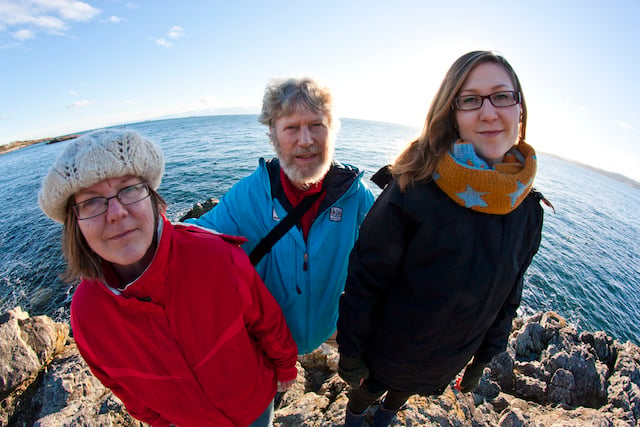
Barbara, myself, and our daughter Meghan lived an almost idyllic lifestyle on Vancouver Island for eight years.
We had just moved into our first home eight months earlier. I was 51, and Barbara was 47. In the spring of 2000, Barbara and I planted a lilac tree, something we had always wanted to do. It was shaping up to be a great summer and a great life.
Then, in the summer of 2000, distressing symptoms of disease appeared for Barbara. Her left leg sporadically would go weak and rainbow auras appeared in her vision sometimes. The family doctor scheduled her for a brain imaging test for a week later.
After the first image was taken, she was told a second image was needed following an injection. The imaging technician suddenly seemed to be more sympathetic. That was the first hint to Barbara that something serious might be wrong. She related her suspicion to me, and I told her it was just her imagination. She was relieved. Yet, I could not sleep well that night. In my dreams, dark clouds and stormy weather was lurking over our paradise.
She went for a biopsy a few days later. They drilled a hole to the center of her brain and took a small sample. A week later, the phone rang, and she had a Sunday appointment with the doctor. Sunday is a strange time for any doctor’s appointment in Canada, so Barbara, myself, and our 11-year-old daughter attended a meeting in which we learned Barbara had a major brain tumor occupying the hollow space in the center of her brain. The tumor, called a “subependymoma,” was the size of a lemon, and it was squeezing her brain, causing the symptoms she had been experiencing.
The tumor was referred to as “semi-benign” because Barbara would require major brain surgery to remove it; one that would result in extensive brain damage. The tumor would have ended her life in less than a year if we did nothing. So, our backs were against the wall. She had no other choice other than a surgery that would result in brain damage.
I was told privately by the surgeon that she would experience unpredictable personality changes because the operation would result in severe damage to the frontal lobes of her brain. This is a similar type of injury which is produced by the now-banned operation known as a “lobotomy,” made famous by the movie “One Flew Over the Cuckoo’s Nest.” I was devastated and faced with possibly losing the woman I loved. I sobbed in private for an hour but told no one else in the family.
The cost of a procedure and recovery in hospital would be hundreds of thousands of dollars. However, because we lived in Canada, with socialized medicine, the entire cost of the operation was free. On the positive side, we had no financial worries about the treatment.
The surgery in September 2000 was “successful,” but, as predicted, the entire frontal lobe area where the personality lives had been seriously harmed by the operation. I was told she would recover but would have to grow a new personality.
When we visited her for the first time after the operation, she was reading the newspaper and looked up at us in a totally unemotional way and then returned to reading. She spoke in a monotone voice. We tried to be as loving as possible on this first visit, but the love coming from her was completely missing. She did not love us anymore. Our dear Barbara was gone. We both cried as we drove home. It was one of the deepest and saddest shocks I have ever experienced. I cried all night.
Barbara’s body was alive but the “Barbara” we knew was gone. On one early visit a few days after the operation, I went in to see her before Meghan did. I told Barbara she had to put her arms around Meghan and say, “I love you.” She had forgotten how to be a mom. Barbara played “the mother role” when Meghan came into the room. After the meeting, Meghan suggested that maybe Mom was coming back after all. I knew this was not really true, and I cried every day for a week whenever I was alone.
After about three weeks, Meghan had an idea. She could sense that her mom was growing a new personality, and it was developing quickly on a daily basis. Meghan suggested that perhaps if we played all the music that Barbara had ever loved from ages 14 to 47 on a daily basis, a personality would grow that liked all that music. Perhaps a similar personality would be the result? It was worth a try. I thought it was a brilliant idea!
Barbara’s computer at home had a complete set of MP3 files that represented all of her favorite music. MP3 players had just been invented in 2000, and we bought one that could hold all of her music. That night, I stayed up until sunrise moving all the music that I knew she loved onto the player. We wanted that player to become part of her recovery protocol at the hospital. We both had new hopes of getting our Barbara back.
The doctors, however, were not sympathetic to our plan at all. They said the music might “overstimulate her.” I asked to see the research that suggested this was actually true, but they didn’t provide any. It was only an opinion. There was no scientific reason to avoid the music. Meghan and I realized she just had to listen to the music if we were ever going to feel the old Barbara in our arms again.
We said we were taking Barbara out of the hospital for the supportive music if the doctors would not allow us to do it there. It was just a bluff, but it worked; the doctors put two hours of music listening on her treatment chart. As Barbara listened every day, she said she saw visions of her life as the music was playing. At one point she kept putting a light blue, silk scarf over her head while listening to Bob Dylan’s “Tangled up in Blue” song.
Within a few weeks, she started to become more and more like the old Barbara. She was finally released from the hospital system within two months.
When she got home, she was listening to her music most of each day.
Barbara’s personality was 100 percent restored in one more month by this miracle of supportive music invented by my daughter, Meghan. Within a year, we all returned to Burlington, Ontario, where Barbara was reunited with family and friends. Her mother and father, brothers, and all her friends pointed out that she was exactly like they remembered her! Her love for us returned too, and it was so good to give her a hug and feel the old spirit of Barbara back with us.
It was the greatest miracle I have ever experienced.
My wife that I loved so dearly had been returned to us through the magic of her music collection. Meghan and I quit crying, and our idyllic life on Vancouver Island had restarted!
This type of frontal lobe brain injury occurs often in car accidents and sports injuries. We want to share our experience of this miraculous cure to potentially help other families recover their loved ones whose personality has been lost to this type of brain injury.
~
~
~
Author: Ian Faulkner
Image: Scotty Ireson, courtesy of author
Editor: Travis May
Copy Editor: Yoli Ramazzina
Social Editor: Nicole Cameron








Read 15 comments and reply